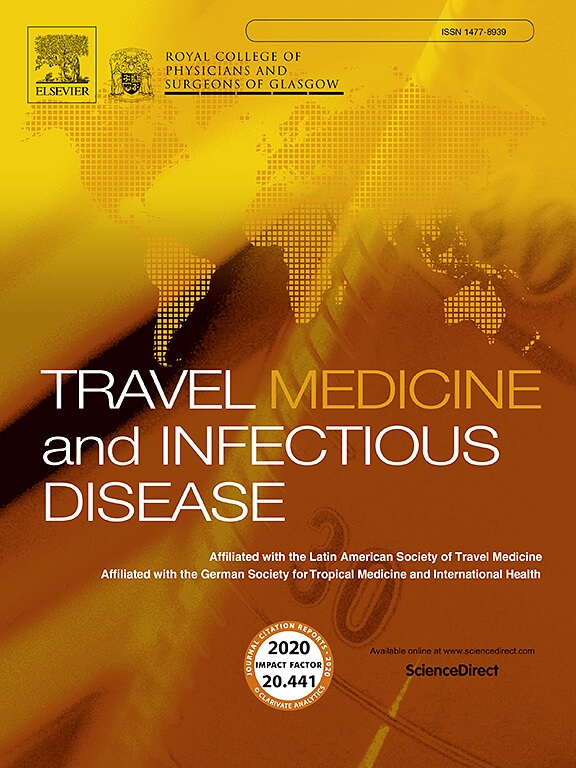The leading “blended” civil medical evacuation operation (MEDEVAC) in unforeseen health emergency. From military use to civil development
IF 6.3
3区 医学
Q1 INFECTIOUS DISEASES
引用次数: 0
Abstract
Introduction
Medical evacuation has historically been rooted in military contexts. It involves the systematic transfer of sick or injured individuals from the battlefield to designated medical facilities. Medical evacuation has found application in civilian settings: the Ebola outbreak and the COVID-19 pandemic. This paper examines the medical evacuation that occurred during the COVID-19 pandemic in Lombardy, Italy (Operation “MEDEVAC”), where overloaded hospitals required the transfer of patients to other regions and even internationally.
Methods
MEDEVAC was implemented by the Regional Emergency and Urgency Agency (AREU). Data from MEDEVAC were analysed using the AREU register, detailing patient characteristics, transfer logistics, and outcomes.
Results
From March to April 2020, 121 intensive care patients were transferred via MEDEVAC, primarily by air. 65 % of patients were moved to other Italian regions. The Federal Republic of Germany received 35 % of patients, all transported by air. Outcome and mortality rates among transferred patients were comparable to those within regional intensive care units. One life-threatening event was reported during transport. The return of patient to Lombardy showed a 100 % survival rate.
Conclusion
This study emphasises the importance of standardised protocols, improved information exchange systems, and enhanced training for medical personnel involved in medical evacuation. MEDEVAC was found to be feasible and able to cope with demands that were excessive in relation to available resources. This study proposes the development of a shared protocol for air transport of patients and a model for international cooperation among emergency response agencies to optimise future medical evacuation activities in civil context.
在突发卫生紧急情况下领先的“混合式”民间医疗后送行动。从军事用途到民用发展
医疗后送历来植根于军事背景。它涉及有系统地将伤病员从战场转移到指定的医疗设施。医疗后送已在平民环境中得到应用:埃博拉疫情和COVID-19大流行。本文研究了在意大利伦巴第(伦巴第)发生的COVID-19大流行期间的医疗后送(“医疗后送”行动),其中超负荷的医院需要将患者转移到其他地区甚至国际上。方法由区域应急机构(AREU)实施。使用AREU登记册分析医疗后送的数据,详细说明患者特征、转院后勤和结果。结果2020年3月至4月,121例重症患者通过医疗后送转移,以空运为主。65%的患者被转移到意大利其他地区。德意志联邦共和国接收了35%的患者,全部通过航空运输。转院患者的预后和死亡率与地区重症监护病房的患者相当。在运输过程中发生了一起危及生命的事件。患者返回伦巴第的存活率为100%。结论本研究强调了规范医疗后送方案、完善信息交流系统和加强对医疗后送医务人员培训的重要性。医疗后送被认为是可行的,并且能够应付相对于现有资源来说过多的需求。本研究建议制定病人空运共享协议和应急机构间国际合作模式,以优化未来民事情况下的医疗后送活动。
本文章由计算机程序翻译,如有差异,请以英文原文为准。
求助全文
约1分钟内获得全文
求助全文
来源期刊

Travel Medicine and Infectious Disease
PUBLIC, ENVIRONMENTAL & OCCUPATIONAL HEALTH-INFECTIOUS DISEASES
CiteScore
19.40
自引率
1.70%
发文量
211
审稿时长
49 days
期刊介绍:
Travel Medicine and Infectious Disease
Publication Scope:
Publishes original papers, reviews, and consensus papers
Primary theme: infectious disease in the context of travel medicine
Focus Areas:
Epidemiology and surveillance of travel-related illness
Prevention and treatment of travel-associated infections
Malaria prevention and treatment
Travellers' diarrhoea
Infections associated with mass gatherings
Migration-related infections
Vaccines and vaccine-preventable disease
Global policy/regulations for disease prevention and control
Practical clinical issues for travel and tropical medicine practitioners
Coverage:
Addresses areas of controversy and debate in travel medicine
Aims to inform guidelines and policy pertinent to travel medicine and the prevention of infectious disease
Publication Features:
Offers a fast peer-review process
Provides early online publication of accepted manuscripts
Aims to publish cutting-edge papers
 求助内容:
求助内容: 应助结果提醒方式:
应助结果提醒方式:


